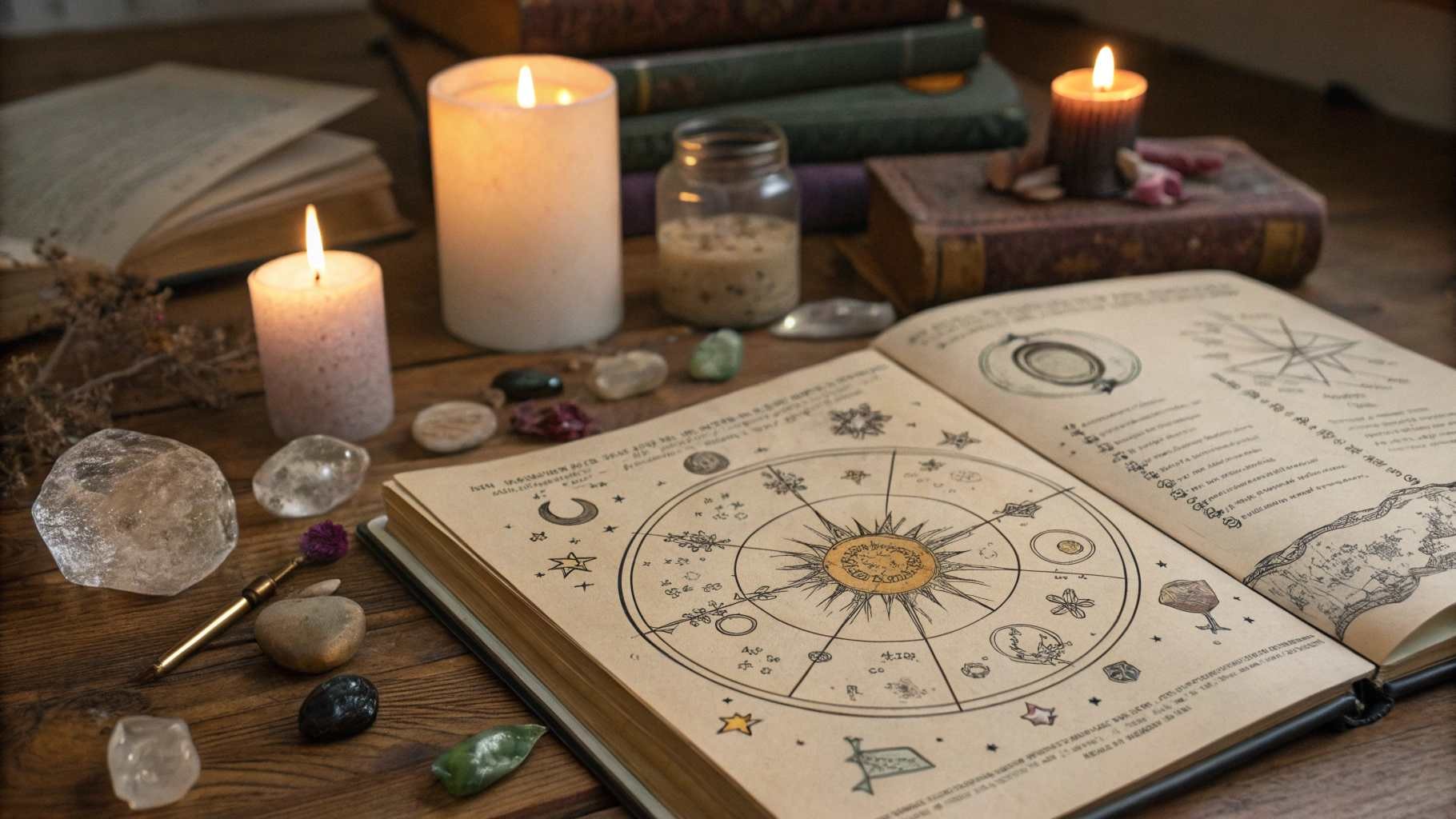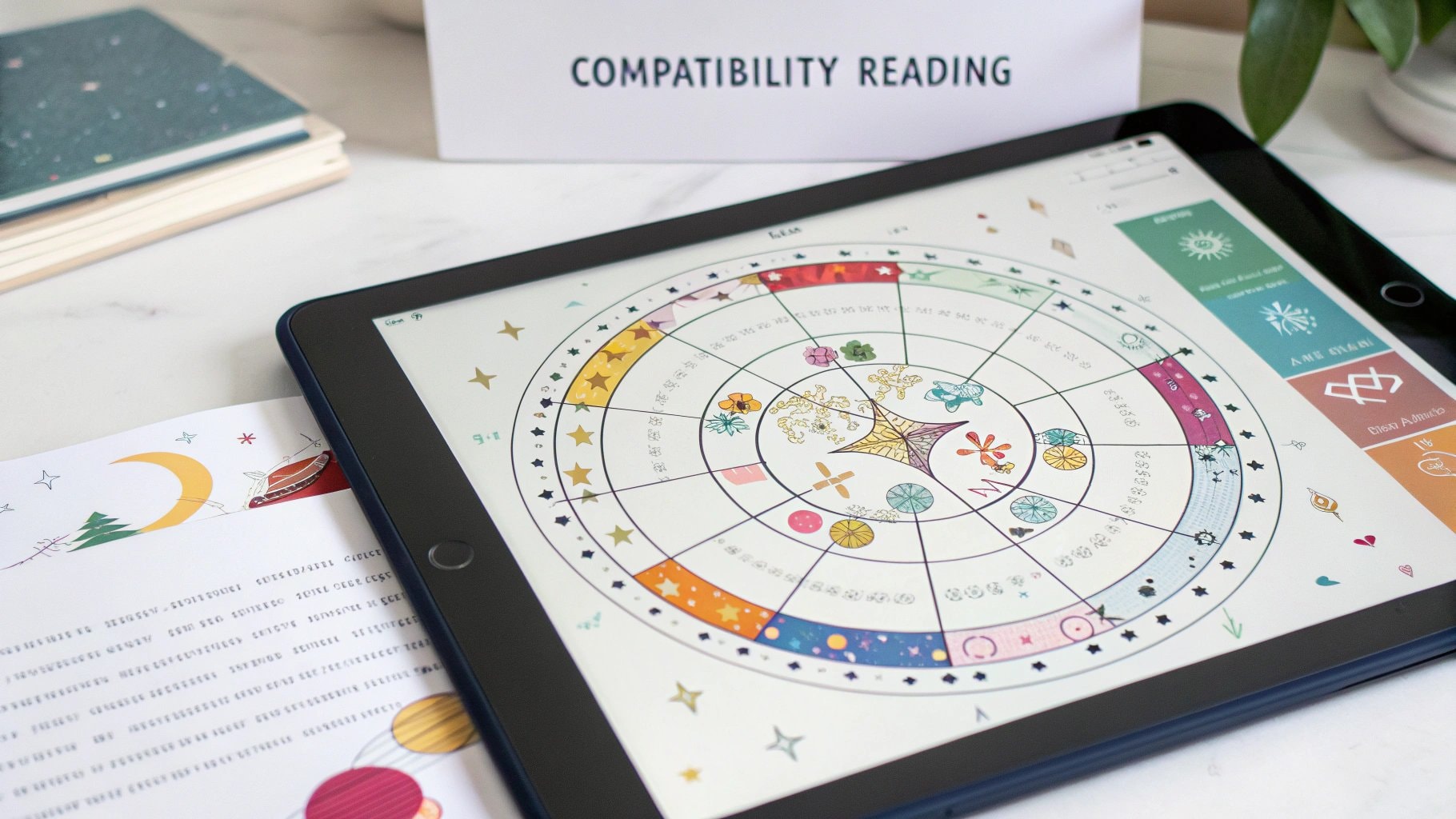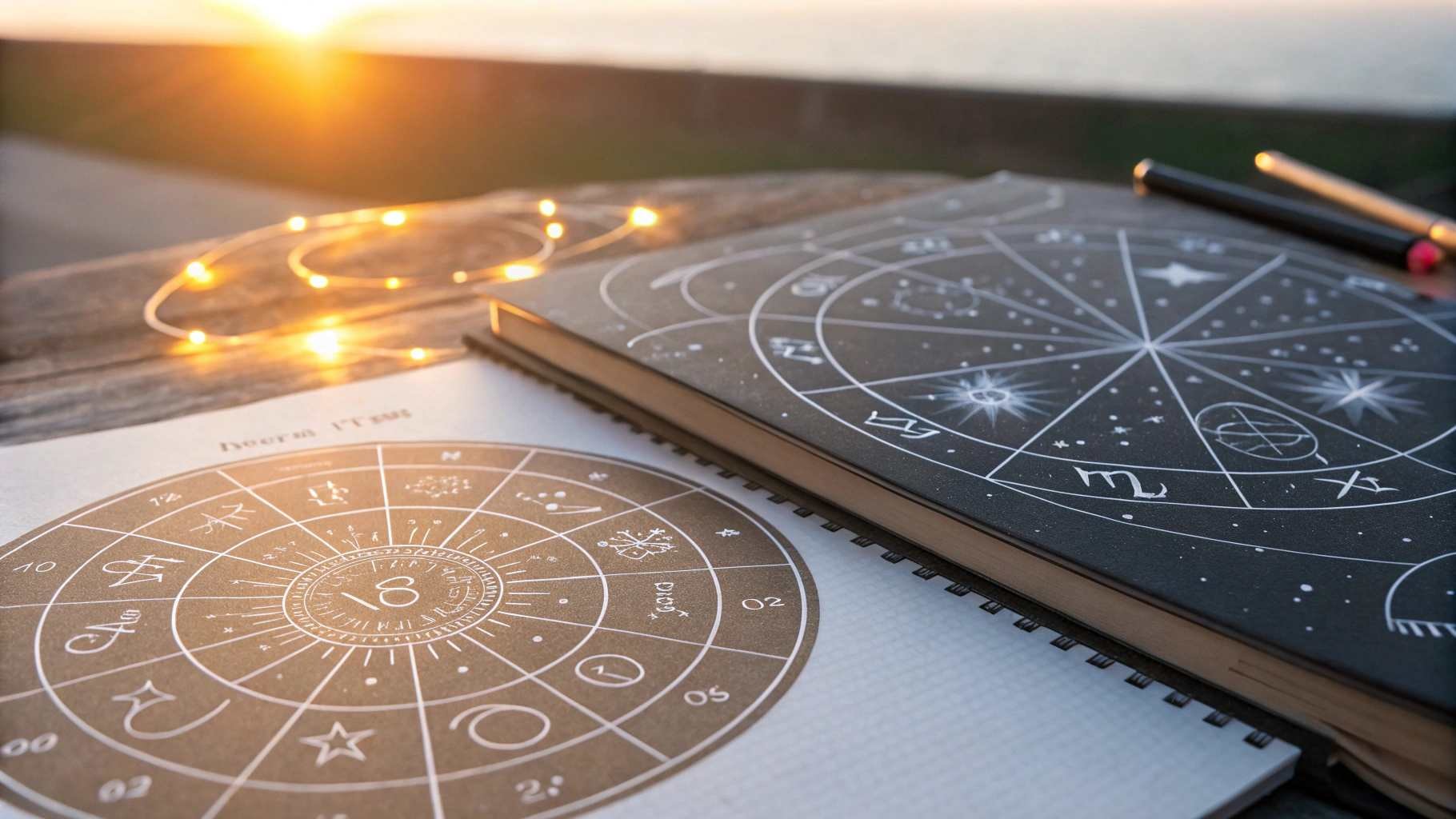- Key Takeaways
- What Are Astrology Charts
- Personal Charts: Different Types of Birth Charts
- Location Charts
- Timing and Forecasting Charts
- Relationship Charts
- Decision Charts
- Conclusion
You want to understand astrology, but the words feel hard. This guide keeps it simple.
An astrology chart is a map of the sky for a time and place. It helps you see patterns in your life.
There are many types of astrology charts. Each one answers a different question about you, your timing, your love life, or your best place to live. Astrology encompasses a wide range of astrological traditions, each offering unique insights into your life and experiences.
By the end, you will know the different types of astrological charts and how to pick the one you need. Exploring different astrological traditions can provide unique insights into your personal journey.
Key Takeaways
- An astrology chart is a sky map for a moment and place. It helps you understand self, timing, love, and location.
- Start with your natal or birth chart. Add other chart types only when you have a clear question.
- For place choices, use astrocartography or a relocated chart to see how a city may feel.
- For planning, use timing charts: transits for now, solar return for the year, lunar return for the month, progressions or solar arc for long shifts. These charts can help you plan for important events.
- For relationships and decisions, use synastry or composite to read bonds, and use horary or electional to answer a question or pick the best start time.
What Are Astrology Charts

An astrology chart is a map of the sky for a moment and place. The exact moment is crucial, as it determines the precise positions of the Sun, Moon, and planets. You can use it to understand yourself and your life.
Each part means something simple.
- Planets show parts of you, like feelings or drive.
- Signs show the style, like calm or bold. The zodiac is the band of the sky divided into twelve signs, which is used to assign meaning to planetary positions.
- Houses show life areas, like home, love, or work.
- Aspects show how the parts talk to each other. An aspect is the angle between two planets in the chart.
Your birth chart is the main map. It uses your birth date, time, and place. Other charts read timing, love matches, or best places to live. These are the different types of astrology charts you will see in this guide.
Personal Charts: Different Types of Birth Charts
These are personal charts, also called types of birth charts. Each one uses your birth date, time, and place. Natal astrology is the branch of astrology focused on analyzing a person’s birth chart to reveal personality traits, life potential, and personal strengths, offering insights into a person’s life.

Natal or Birth Chart
This is your main map. It shows who you are, your gifts, your lessons, and your life path. To read it with ease, look at your Sun, Moon, and Rising first, then notice which life areas feel strong, like love, work, or home.
Your sun sign is the zodiac sign the sun was in at your birth and is often used for personality insights.
If you do not know your exact birth time, ask family or check a record. If you still cannot find it, you can start with a noon chart as a rough view.
Use this chart when you want self understanding, career clues, and simple next steps that fit you.
Relocated Birth Chart
This chart moves your birth map to a new city. It helps you feel how life may change in another place. Your Rising sign and houses can shift, so work, love, or home may feel stronger or softer by city.
Use this when you plan a move, a long trip, or remote work from a new place. Compare two cities, read how each chart feels, and pick the one that supports your values and daily needs.
This is one of the most useful types of astrological charts when you face a place choice.
Draconic Chart
This chart uses the lunar nodes to point to soul aims and deep values. Some astrologers use the draconic chart to explore past lives and the soul’s journey, revealing how previous incarnations influence your current spiritual path. It shows what feels meaningful under the surface and why certain paths keep calling you.
Read the Sun, Moon, and Rising in the draconic chart, then compare them to your natal chart. Write one clear line about what truly matters to you, and use it to guide daily choices.
This is helpful when you want purpose themes from the different types of astrology charts.
Harmonic Charts
These charts zoom in on pattern with numbers. They highlight talents and fine detail that a natal chart can hide. Some harmonics focus on creative flow, learning, or faith, so you can test where your natural strengths live.
Start with one harmonic at a time and compare it to your natal chart. Keep one or two insights and try them in real life, like a short project or practice plan.
When you want fine tuning beyond the basics, harmonic charts add depth to the main types of birth charts.
Location Charts

Astrocartography Map
An astrocartography map is your birth chart on a world map. It shows where each planet feels strongest for you in different places on Earth.
The map draws lines for each planet. A line runs through places where that planet was rising, overhead, setting, or underfoot at your birth. The closer you are to a line, the more you tend to feel that planet’s theme.
Sun lines can make you feel seen and brave. Venus lines can bring ease in love and art. Jupiter lines can support growth and luck. Moon lines can help home and family. Mercury lines can boost study, writing, and talks. Mars lines can add drive and courage. Saturn lines can ask for duty and steady work.
You use the map by picking a goal, then matching it to a planet. If you want love, check places near a Venus line. If you want career growth, look near Sun or Jupiter lines. If you want rest, a Moon line may help.
Think of the map as a guide, not a rule. It does not force events. It shows the tone a place may have for you so you can choose with more clarity.
Timing and Forecasting Charts
Transit Chart
A transit chart shows today’s sky on top of your birth chart. Transit charts track planetary movements and compare current planetary positions to your natal chart. It helps with near term timing, from a day to a few weeks. You can see why a day feels easy or tense, and when to act or rest.
To read it fast, see which current planets touch your Sun, Moon, or Rising, and which house they move through. If a transit hits your career house, plan key calls or pitches.
Example: Mars crosses your third house. You get a push to speak up, send emails, and move ideas. Use the energy, but keep your words clear and kind.
Progressed Chart
A progressed chart moves your birth chart forward a little each year. Progressions are based on the natal positions of the planets and show how these positions evolve over time. It shows slow inner growth that lasts months or years. It tells you what you feel ready to become.
Start with the progressed Sun and Moon. The Sun shows your long theme. The Moon shows mood shifts that last about two to three years per sign.
Example: Your progressed Moon enters Cancer. Home, family, and comfort feel important. You cook more, nest more, and say yes to safe, warm plans.
Solar Return Chart
A solar return chart begins on your birthday each year. Solar return charts are usually calculated using the tropical zodiac, which is the primary system in Western astrology for defining zodiac signs and timing celestial events. It frames the story from this birthday to the next. It is your yearly weather report.
Read the house of the Sun for the main focus. Check the Moon for tone, and the Rising sign for how the year feels. Set one to three goals that match this map.
Example: The Sun lands in your tenth house. Career steps rise to the top. You polish your profile, ask for feedback, and take a clear step toward a role you want.
Lunar Return Chart
A lunar return chart begins each month when the Moon returns to its birth spot. The chart is cast for the exact time the moon’s position matches its place at your birth. It shows the month ahead and your emotional focus.
Read the Moon’s house to see which life area lights up. Use it for self care, short plans, and quick choices you can finish this month.
Example: The Moon falls in your seventh house. One to one talks matter. You plan date nights, client check ins, or clear chats that build trust.
Solar Arc Directions
Solar arc directions move every planet by the same small amount each year. Astrologers also watch when solar arc planets cross house cusps, as these moments can signal key life shifts. They point to long range triggers and turning points.
Watch when a solar arc planet meets your natal Sun, Moon, Rising, or Midheaven. These hits often line up with moves, new roles, or fresh identity stages.
Example: Solar arc Midheaven meets your natal Jupiter. Career doors open. You see growth chances, say yes to a bigger task, and step into wider reach.
Relationship Charts

Synastry Chart
In a synastry chart, you compare two birth charts to see how your planets talk to each other. You find the easy flow and the tricky spots. You learn why some things feel simple together and why some moments feel tense.
You start with the basics. You look at the Sun and Moon for core needs. Comparing each person’s zodiac sign can reveal compatibility and differences. You check Mercury for how you both speak and listen. You check Venus and Mars for love and spark.
Then you notice where their planets land in your houses, like your love house or career house.
You use synastry when you date, build a bond, or work closely with someone. It does not lock your future. It gives you a clear map so you can choose kinder words and better habits.
Composite Chart
In a composite chart, you blend two charts into one chart of the relationship. You read it as the “we” energy, not “you” and “me.” It tells you what the bond wants and how it feels when you act as a team.
You look at the Sun for the purpose of the bond. You look at the Moon for the daily mood. You check the Rising sign to see how others see you together.
The ascendant in a composite chart is calculated as the midpoint between both birth charts. Strong houses show where the bond grows best, like home, travel, or shared work.
You use a composite chart for steady, ongoing bonds. It helps you set simple plans that fit the tone of the relationship so life together feels smoother.
Davison Relationship Chart
In a Davison chart, you take the halfway point between both births in time and place and make one chart from it. You treat it like the birth chart of the relationship itself. You can use different house systems to interpret the Davison chart, and the choice of house system may affect how you analyze the planetary positions and life areas represented.
You read the Sun, Moon, and Rising first. You see which parts of life light up, like home, love, or career. You watch current sky movements on this chart to time talks, moves, and fresh starts.
You use the Davison chart when a link feels fated or reaches a turning point. For the clearest picture, you read synastry for fit, composite for shared mood, and Davison for the journey, then you act on the theme they all repeat.
Decision Charts
Horary Astrology Chart
In a horary chart, you cast a chart for one clear question at the exact time and place you ask it. You do not need your birth time. The chart helps you read yes or no, and it can point to where or when.
Keep your question simple, like “Will I get this job?” or “Where are my keys?” Horary astrology is commonly used to locate lost objects and to answer specific questions about relationships, career, or timing.
Read the key houses for the topic and watch how the main signs connect. If they link, the answer leans yes. If they do not, it leans no. You can also see timing hints for days or weeks.
Use horary when you feel stuck and want a direct nudge.
Electional Astrology Chart
In an electional chart, you pick the best time to start something important. It is crucial to select the exact moment for the event, as this precise timing can greatly influence the outcome. You set the goal, the place, and a date range, then you search for a moment that supports the plan.
Match the chart to the goal. Choose strong Venus for love events, steady Moon for peace at home, Mercury for signing papers, and Jupiter for growth or launches.
Lock the place because the location changes the chart. Create two or three good windows and then choose the one that also fits real life.
Use electional charts for weddings, product launches, travel starts, and any big step you want to begin well.
Conclusion
You now know what an astrology chart is and when to use each type. You can read personal charts for self insight, location charts for place choices, timing charts for planning, relationship charts for bonds, and decision charts for clear questions.
Start with your natal chart. Add transits for the moment. Use a solar return for the year. Try progressions or solar arc for long shifts.
Use synastry and composite for love. Use astrocartography or a relocated chart for moves. Use horary or electional when you need a yes, a date, or a best start time.
If you want a quick way to try these, you can check this page for all chart tools in one place.